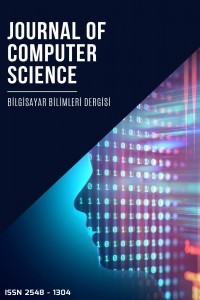Development of Text Summarization Method based on Graph Theory and Malatya Centrality Algorithm
Graph-Based Text Summarization, Malatya Centrality Algorithm, Text Summarization
Development of Text Summarization Method based on Graph Theory and Malatya Centrality Algorithm
___
- Yakut S, Oztemiz F, Karci A(07.12.2022 ). A New Approach Based on Centrality Value in Solving the Minimum Vertex Cover Problem: Malatya Centrality Algorithm. Computer Science. Volume Vol:7, Issue Issue:2, 81 - 88.
- Hark C, Taner Uçkan T, Seyyarer E. , Karcı A(30.09.2019). Metin Özetlemesi için Düğüm Merkezliklerine Dayalı Denetimsiz Bir Yaklaşım dergipark, 8(3).
- Hark C, Taner Uçkan T, Karcı A(29.06.2022). A new multi-document summarisation approach using saplings growing-up optimisation algorithms: Simultaneously optimised coverage and diversity
- Erhandı, B. (2020). Derin Öğrenme ile Metin Özetleme
- Tülek, M. (2007). Türkçe için Metin Özetleme
- Kaynar, O., IŞIK, Y. E., GÖRMEZ, Y., & DEMİRKOPARAN, F. (2017). Genetic Algorithmn Based Sentence Extraction For Automatic Text Summarization. dergipark, 3(2).
- Khushboo S. Thakkar, R.V. Dharaskar, & M.B. Chandak. (2010). Graph-Based Algorithms for Text Summarization. IEEE. 10.1109/ICETET.2010.104
- Güneş Erkan, & Dragomir R. Radev. (2004). LexRank: Graph-based Lexical Centrality as Saliencein Text Summarization.
- Ibrahim F. Moawad, & Mostafa Aref. (2013). Semantic graph reduction approach for abstractive Text Summarization. IEEE. 10.1109/ICCES.2012.6408498
- Rafael Ferreira, Frederico Freitas, Luciano de Souza Cabral, Rafael Dueire Lins, Rinaldo Lima, Gabriel França, Steven J. Simskez, & Luciano Favaro. (2013). A Four Dimension Graph Model for Automatic Text Summarization. IEEE. 10.1109/WI-IAT.2013.55
- Joel Larocca Neto, Alex A. Freitas, & Celso A. A. Kaestner. (2003). Automatic Text Summarization Using a Machine Learning Approach. springer.
- Karel Ježek, & Josef Steinberger. (2007). Automatic Text Summarization (The state of the art 2007 and new challenges).
- Chirantana Mallick, Ajit Kumar Das, Madhurima Dutta, Asit Kumar Das, & Apurba Sarkar. (2018). Graph-Based Text Summarization Using Modified TextRank. springer.
- Rada Mihalcea. (2004). Graph-based Ranking Algorithms for Sentence Extraction, Applied to Text Summarization.
- Makbule Gulcin Ozsoy, & Ferda Nur Alpaslan. (2011). Text summarization using Latent Semantic Analysis. 10.1177/0165551511408848
- Yogesh Sankarasubramaniam, Krishnan Ramanathan, & Subhankar Ghosh. (2014). Text summarization using Wikipedia. sciencedirect.
- Rasim ALGULIEV, & Ramiz ALIGULIYEV. (2009). Evolutionary Algorithm for Extractive Text Summarization. Scientific Research.
- Naresh Kumar Nagwani, & Dr. Shrish Verma. (2011). A Frequent Term and Semantic Similarity based Single Document Text Summarization Algorithm. researchgate.
- Raed Z. Al-Abdallah, & Ahmad T. Al-Taani. (2017). Arabic Single-Document Text Summarization Using Particle Swarm Optimization Algorithm. sciencedirect.
- S.A. Babar, & Pallavi D. Patil. (2015). Improving Performance of Text Summarization. sciencedirect.
- Arti Jain, Anuja Arora, Jorge Morato, Divakar Yadav, & Kumar Vimal Kumar. (2022). Automatic Text Summarization for Hindi Using Real Coded Genetic Algorithm. mdpi.
- Carlos N. Silla Jr., Gisele L. Pappa, Alex A. Freitas, & Celso A. A. Kaestner. (2004). Automatic Text Summarization with Genetic Algorithm-Based Attribute Selection. springer.
- Sumya Akter, Aysa Siddika Asa, Md. Palash Uddin, Md. Delowar Hossain, Shikhor Kumer Roy, & Masud Ibn Afjal. (2017). An extractive text summarization technique for Bengali document(s) using K-means clustering algorithm. IEEE. 10.1109/ICIVPR.2017.7890883
- ISSN: 2548-1304
- Yayın Aralığı: Yılda 2 Sayı
- Başlangıç: 2016
- Yayıncı: Ali KARCI
Fonolojik Hataların Değerlendirme Metriklerindeki Rolü
Ayşegül ÇAĞLI, Vakkas KARAKURT, Kürşat Edabalı YILDIRIM, Fatih SOYGAZİ, Yılmaz KILIÇASLAN
Türkçe Duygu Sınıflandırma İçin Transformers Tabanlı Mimarilerin Karşılaştırılmalı Analizi
Nesnelerin İnternetinde Dallanmasız Programlama Tekniklerinin Uygulanması
Muhammed Saadetdin KAYA, Kenan İNCE
Aralık Tip-2 Bulanık TOPSIS Yöntemi Kullanılarak Çalışan Performansının Değerlendirilmesi
Development of Text Summarization Method based on Graph Theory and Malatya Centrality Algorithm
Selman YAKUT, Cevher Tayyib BAKAN
Muhammed Salih TATAR, Rabia KÖK, Aybars UGUR
Sayısal Global Optimum için Çift-Girişim Tabanlı İyileştirme Algoritmasının Yakınsama Analizi
